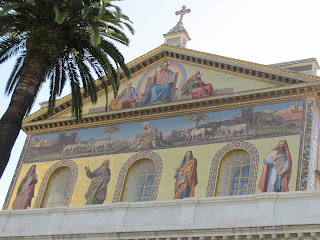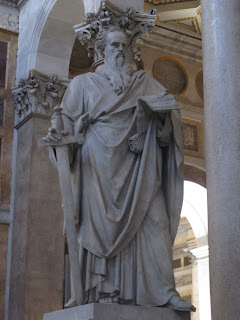We started yesterday by visiting St. Paul's Outisde the Walls. This was the last major construction project of Imperial Rome. It was completed in 380 AD. Although physically detached, it is considered to be part of the Vatican. It was recreated after a fire in 1823. The ceiling and the cloister of San Paolo (both spared by the fire) are fantastic. This was the largest Christian church in the world until the new St Peter's was constructed in the 1500s. Christians believe the Paul's body is buried beneath the alter. He was decapitated two miles from here and his head is in San Giovanni in Laterno which we visited a few days ago. Here are some of our pictures:
 |
| The palm trees make it look like Arizona but believe me we are in Rome. |
 |
| The doors to the church were incredible! |
 |
| This is an Easter Candle holder |
 |
| Look at the detail. This part of the church was built in 380 AD and never consumed by fire. |
 |
| Again, these columns were created in 380 AD |
Our next stop was at the catacombs. We had heard about this place most of our lives so we were looking forward to seeing them. We were not disappointed. The Catacombs of Callisto or Sebastiano had both pagan and Christian bodies buried in them. Most of the pagans were cremated. However, Christians believed they would rise again and "live" when Jesus returned so being reduced to a pile of ashes was problematic for them. Since Roman law forbid burials within the City Walls, comsone found these soft sandstone areas and caves with graves were begun. They are over 40 catacombs but these are the two largest and most famous. The Catacombs encompassed over 360 miles of underground tunnels and were the burial ground for over 80,000 bodies. After Constantine legalizedChristianity, the Christians began making pilgrimages to the early martyrs buried here and held services here. After the barbarians sacked Rome, the catacombs were forgotten for 1,000 years and only rediscovered in 1850. Early Popes were buried in Callisto. Some Christians claim Peter and Paul's bones were hidden in Sebastiano in the 3rd Century. The bones have been removed and are out of sight. We were not allowed to take pictures in the catacombs but here is the outside structure.
About 1/3 of a mile from the catacombs was the beginning of the Appian Way. Since we didn't have our camera for the catacombs, we didn't have the camera for the Appian Way. The Romans began building the Appian Way in 300 BC and it became the world's first "super-highway." Paul was taken along it as a prisoner to Rome in 56 AD. Abandoned in the Middle Ages, it is surrounded by ruined tombs of wealthy Roman families. It was comprised of large black smooth stones. Every easy to walk on (and probably easy to pull a chariot or wagon on) unlike the cobble stones we found in most of the historic cities we have visited.
We ended the day with a private tour of the Villa Borghese and its gallery which was started with champaign and appetizers and ended with a catered dinner with candlelight on the balcony overlooking the garden. The Borghese Gallery and Museum is one of the world's incredible art collections of sculptures and paintings founded by Cardinal Scipione Borghese (nephew of Pope Pius V) in which we get to see the art in it original setting. The art that we viewed has never been moved out of the villa in 500 years On the first floor was a nude sculpture of Napoleon's sister as Venus and it was a big scandal in Europe. When asked "how could you do it" she quipped "The room wasn't cold." Her furious husband had the sculpture hidden away for years. The Borghese Gardens are amongst the most famous and beautiful in Italy and offer stunning views of Piazza del Popolo. There were a number of Bernini sculptures in the collection and Bill has made us all fans of his work. We saw his "Apollo and Daphne" and "David" sculptures. Incredible!! Of course, we could not take pictures except during the reception so here are a few of your friends:
Although today was our last day in Rome, it was packed with great things to do. First we were off to the Colosseum. Although there were still long lines at 9:00 a.m., we were able to dash by them and go straight in. We don't know how the guides did it but we were not going to ask. We told you all about the Colosseum a few days ago so we don't repeat ourselves but here are a couple of interesting facts we learned today. The gladiators did not just kill lions and tigers but also boars, giraffes and anything else they thought might be interesting. There were only about 20 matches a year in the Colosseum. Men and women were not allowed to sit together---I think that was so the ladies could discuss the finer qualities of the gladiators!
We took lots of pictures but here are a few.
We dashed over to the Church of St Theresa to see another Bernini sculpture. Here are a few church pictures.
Our last stop in Rone was very impressive. We visited the Villa Biulla. This is a fantastic villa beside the Borghese Palace and is the most important Etruscan museum in Italy. The villa was built between 1550-1555 AD as a summer home for Pope Julius III. The Etruscans BC and controlled it for 200 years. They were ousted by the formation of the Roman Republic. It was unbelievable to see the quality of the collect from 500-700 BC! We couldn't take pictures but we took a few before we knew better.
Then, off to the airport and we took a short flight to Geneva, Switzerland. Geneva is the center of French Sqitzerland. This is a tur international city. It is or has been home to the International Bank of Settlements, The League of nations, the United Nations European headquarters, the World Health Organization and the International Red Cross. Charlie Chaplin even lieved here! Long before Chaplin, Calvin lad a Reformation movement here.
Situated on Lake Geneva, many think Geneva is big and dull. It isn't. Just 185,000 people live here and it's filled with great restaurants and museums. Split by the Rhone River flowing out of Lake Geneva, Geneva has an Old Town and Rive Gauche with ritzy hotels. Geneva's landmarkd emblem in the spectacular Jet d'Eau Fountain which shoots 500 feet in the air. Of course, our hotel is on the Rive Gauche. Here are some pictures from our hotel room window.
We start our tour of Geneva early tomorrow morning so need to head to bed. Looking forward to learning more about Geneva and Switzerland's history.
Jack and Nancy



































No comments:
Post a Comment